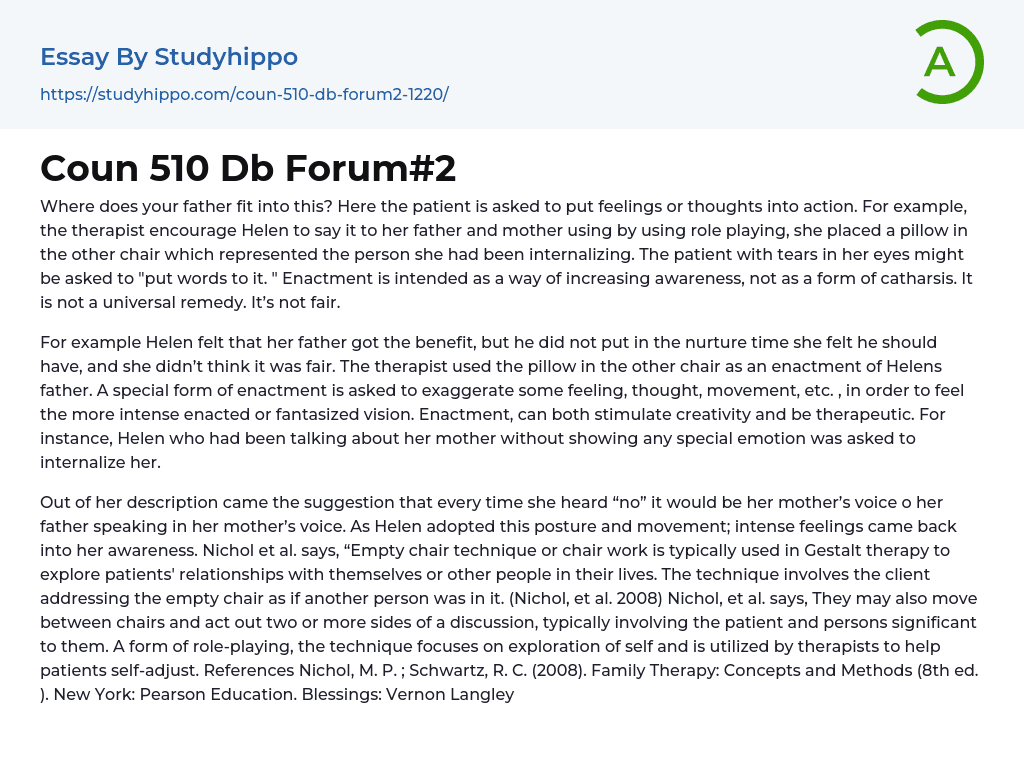Where does your father fit into this? The patient is asked to put feelings or thoughts into action. For instance, the therapist encourages Helen to verbalize her emotions and interact with her father and mother through role-playing. To symbolize the person she had been internalizing, she places a pillow on the chair. The patient, with tears streaming down her face, may be requested to "express it in words." Enactment serves as a means to enhance consciousness rather than a cathartic solution. It is not a universally effective treatment. It is unjust.
For instance, Helen believed that her father received the advantage, but she felt that he did not invest the amount of time taking care of her that she thought he should have, leading her to view it as unfair. The therapist used a pillow positioned in another chair as a representation of He
...len's father. This technique, known as enactment, involves exaggerating certain emotions, thoughts, movements, etc., in order to experience a more intense enacted or fantasized version. Enactment serves both as a means to enhance creativity and promote therapy. For example, Helen, who had been discussing her mother without displaying any particular emotions, was asked to internalize her feelings.
Based on her description, she proposed the idea that whenever she heard the word "no," it would remind her of her mother or her father speaking in her mother's voice. As Helen took on this posture and movement, she became aware once again of intense emotions. According to Nichol et al. (2008), the empty chair technique, also known as chair work, is commonly used in Gestalt therapy to explore a patient's relationships with themselves or others. Thi
technique involves the client addressing an empty chair as if another person were sitting in it. The authors further explain that the patient may switch between chairs and act out various roles in a discussion, usually involving themselves and important individuals in their lives. As a form of role-playing, this technique is focused on self-exploration and helps patients make self-adjustments with the assistance of therapists (Nichol & Schwartz, 2008).
Reference: Nichol, M. P.; Schwartz, R. C. (2008). Family Therapy: Concepts and Methods (8th ed.). New York: Pearson Education.
Blessings: Vernon Langley
- Anatomy and Physiology essays
- Addiction essays
- Biodegradation essays
- Dental Care essays
- Disease essays
- Disorders essays
- Health Care essays
- Intelligence Quotient essays
- Nutrition essays
- Olfaction essays
- Public Health essays
- Women's Health essays
- World health organization essays
- Cancer essays
- Infectious Disease essays
- Lung Cancer essays
- Neurology essays
- Physical Exercise essays
- Medicine essays
- Sex essays
- Inquiry essays
- Disability essays
- Poison essays
- Action Potential essays
- Nervous System essays
- Childbirth essays
- Puberty essays
- Blood essays
- Kidney essays
- Neuron essays
- Body essays
- Glucose essays
- Sense essays
- Heart essays
- Skeleton essays
- Human Physiology essays
- Eye essays
- Immune System essays
- Muscle essays
- Skin essays
- Brain essays
- Central Nervous System essays
- Human Skin Color essays
- Digestive System essays
- Common sense essays
- Respiration essays
- alcoholism essays
- Smoking essays
- Casino essays
- Tobacco essays




